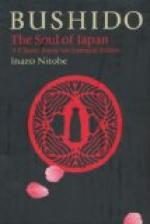society (and what is feudal society if not militant?)
the position of woman is necessarily low, improving
only as society becomes more industrial. Now is
M. Guizot’s theory true of Japan, or is Mr.
Spencer’s? In reply I might aver that both
are right. The military class in Japan was restricted
to the samurai, comprising nearly 2,000,000 souls.
Above them were the military nobles, the
daimio,
and the court nobles, the
kuge—these
higher, sybaritical nobles being fighters only in name.
Below them were masses of the common people—mechanics,
tradesmen, and peasants—whose life was
devoted to arts of peace. Thus what Herbert Spencer
gives as the characteristics of a militant type of
society may be said to have been exclusively confined
to the samurai class, while those of the industrial
type were applicable to the classes above and below
it. This is well illustrated by the position
of woman; for in no class did she experience less
freedom than among the samurai. Strange to say,
the lower the social class—as, for instance,
among small artisans—the more equal was
the position of husband and wife. Among the higher
nobility, too, the difference in the relations of
the sexes was less marked, chiefly because there were
few occasions to bring the differences of sex into
prominence, the leisurely nobleman having become literally
effeminate. Thus Spencer’s dictum was fully
exemplified in Old Japan. As to Guizot’s,
those who read his presentation of a feudal community
will remember that he had the higher nobility especially
under consideration, so that his generalization applies
to the
daimio and the
kuge.
I shall be guilty of gross injustice to historical
truth if my words give one a very low opinion of the
status of woman under Bushido. I do not hesitate
to state that she was not treated as man’s equal;
but until we learn to discriminate between difference
and inequalities, there will always be misunderstandings
upon this subject.
When we think in how few respects men are equal among
themselves, e.g., before law courts or voting
polls, it seems idle to trouble ourselves with a discussion
on the equality of sexes. When, the American
Declaration of Independence said that all men were
created equal, it had no reference to their mental
or physical gifts: it simply repeated what Ulpian
long ago announced, that before the law all men are
equal. Legal rights were in this case the measure
of their equality. Were the law the only scale
by which to measure the position of woman in a community,
it would be as easy to tell where she stands as to
give her avoirdupois in pounds and ounces. But
the question is: Is there a correct standard in
comparing the relative social position of the sexes?
Is it right, is it enough, to compare woman’s
status to man’s as the value of silver is compared
with that of gold, and give the ratio numerically?
Such a method of calculation excludes from consideration




